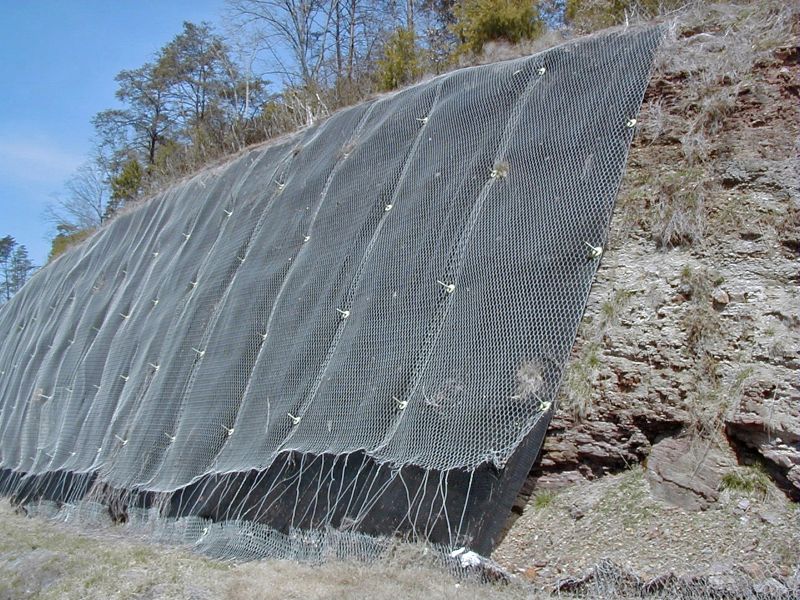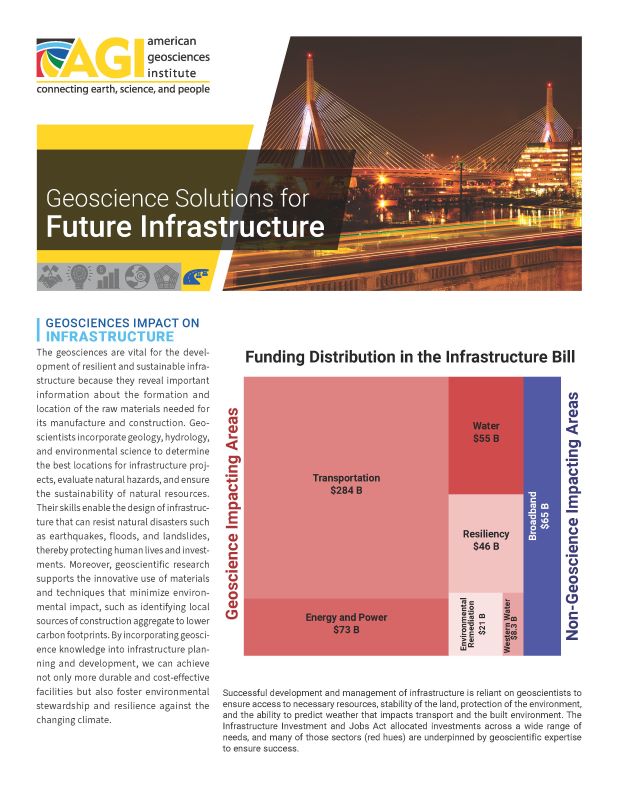Geoscience Solutions for Future Infrastructure

Geoscience lays the foundation for resilient and sustainable infrastructure, guiding material sourcing, hazard assessment, and climate adaptation. Geoscientific insights drive innovations that shape safer, smarter cities and sustainable development for generations to come.
Geosciences Impact on Infrastructure
On Stable Ground
Topographic and geologic information informs where infrastructure can be safely located as well as sites for the safe disposal of infrastructure waste products.
Critical Minerals for All Development
Geologic resource information is required to locate new sources of needed critical minerals and other raw materials.
Safe and Sustainable Development
Environmental geologists provide the guidance and information needed to ensure projects can be built safely and sustainably.
Location for Future Energy
Climate scientists develop projections for long-term climate trends for improved planning for wind and solar energy developments, as well as the energy transmission infrastructure that will be critical for building a 21st century energy grid.
Building for the Long Haul
The design and construction of bridges, roads, pipelines, aqueducts, and levees are directly influenced by numerous geologic factors, including the structural integrity of the substrate and the subsurface conditions upon which the structures will be built.
Wise Development for Reduced Risk and Cost
Incorporating geoscience information into infrastructure construction maximizes the safety and efficiency of our systems, saving money and reducing risks.
Waste Management
Geoscientists contribute to the design and monitoring of waste disposal sites, including landfills and hazardous waste containment facilities. They ensure that these sites do not contaminate groundwater or soil and assess remediation options for contaminated sites, making them safe for future use or development.
Urban Planning and Smart Cities
Geoscientific data and analysis support urban planning by providing insights into land use, natural resource availability, and environmental constraints. This information is crucial for the sustainable development of smart cities, which aim to optimize resource use, reduce pollution, and improve residents' quality of life.
Exemplars of Impacts of Geoscience on Infrastructure

As the Nation transitions its energy portfolio, geoscience research can significantly aid in maximizing the economic return on investment through incorporation of geological information for construction of solar, wind, geothermal, hydroelectric, and nuclear power developments to reduce costs and construction time.
Residential and business structures in both cities and rural areas require stable foundations to ensure long-term stability and sustainability as well as protect against natural hazards such as earthquakes, wind, flooding, landslides, and sinkholes, and erosion.
Water can cause extreme problems for infrastructure. For example, saline water associated with rising sea-levels can react with concrete-supported infrastructure, weakening the concrete and corroding support steel, leading to reduced useful lifetimes. Urban areas contain a high percentage of impermeable surfaces, and thus need hydrologic modelling and design to manage storm water and runoff. This is critical information for developing resilient and cost-effective city and suburban landscapes. Creative designs will be needed to make new infrastructure as efficient and adaptable as possible to counter the uncertainties related to climate change.
Case Studies
Examples of Relevant Legislation and Policy
Executive Orders
- E.O. 13956: Aims to modernize water resource management and infrastructure particularly to improve water storage capacity and drought resilience.
Congressional Legislation
- 117th — H.R. 5376: The Inflation Reduction Act spurred on massive investments in new infrastructure efforts across the United States.
- 118th— H.R. 302: direction for the Department of Energy to provide assistance programs for graduate students and post-grad researchers in pursuance of research focused on cyber security and energy infrastructure
Relevant Federal Agencies
- Bureau of Ocean Energy Management
- Environmental Protection Agency
- US Department of Transportation
- Army Corps of Engineers
- Department of Energy
Related National Academy Reports
- Transforming EPA Science to Meet Today’s and Tomorrow’s Challenges (2023)
- Benefits, Applications, and Opportunities of Natural Infrastructure: Proceedings of a Workshop—in Brief (2022)
- Climate-Resilient Supply Chains: Proceedings of a Workshop–in Brief (2022)
- Planning the Future Space Weather Operations and Research Infrastructure: Proceedings of a Workshop (2021)
Non-Partisan Non-Profit Expertise
- American Association of Geographers
- American Association of Petroleum Geologists
- American Institute of Hydrology
- American Institute of Professional Geologists
- Association of American State Geologists
- Association of Environmental and Engineering Geologists
- Mineralogical Society of America
- National Groundwater Association
- National Sand, Stone, and Gravel Association
- Society of Economic Geologists
- Society of Exploration Geophysicists
- Society for Mining, Metallurgy, and Exploration



